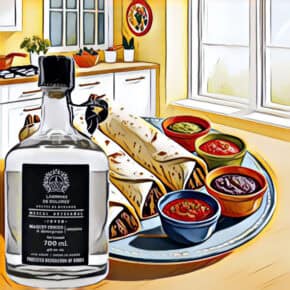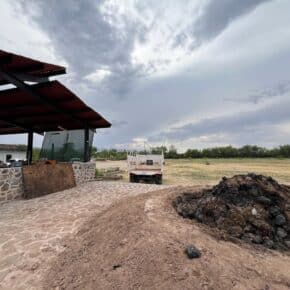Details
- Location: Nombre de Dios, Durango
- Agave: Cenizo / A. durangensis
- Maestro Mezcalero: Manuel Simental
- ABV: 48%
- Tasting keywords: Rich, fruity.
- NOM: D529G
- Buy it today
Nose
Rich and fruity – It reminds me of a fresh blanco tequila.
Taste
Medium bodied at the front, then a burst of cayenne pepper, pickle juice, and cinnamon until it mellows out with a tail of piloncillo sugar. These are the flavors of the north! Amazingly smooth for a 48% ABV mezcal.
Method / Background Notes
The Simental family is well known in the Durango distilling world, members distill for a number of internationally distributed brands including Derrumbes and Clase Azul as well as domestic brands. Manuel Simental distills out of the “Mal Pais” vinata. I’ve tasted another of his creations, the Amormata “Nación de las Verdes Matas Familia Simental” which I liked quite a bit.
Sacro Imperio has been available in Mexico since 2015 but only appeared in the US starting in 2019 after Manuel Lizarraga started importing it. Like many, Lizarraga had fallen hard for mezcal and tasted his way around the spectrum but when he moved to Mazatlan and met Simental in 2017 he started down a different path. A graphic designer by background, he became the one man import company (or as he puts it “Still a one man business, but I get a lot of help.” which seems to be a constant refrain in the mezcal business.) who will soon be bringing in other brands as well. Today Sacro Imperio is available in California, Oregon, and New York with ambitions to grow into other markets soon.
The Sacro Imperio Cenizo is made from wild harvested Agave durangensis. The team leases hillside land, brings the piñas down by mule, and then trucks them to the Mal Pais vinata. They follow the CRM guidelines for harvesting so they leave a percentage of the wild agaves to reproduce for future generations but the company also maintains an reforestation project as well.
The agaves are roasted in conical, volcanic rock lined, ovens for three to four days. Then they are broken into smaller pieces with an axe before being mechanically shredded.
Fermentation is in open cypress tubs which are buried up to their lips because the temperature swings in Durango’s high desert are quite aggressive. Mal Pais is located at c2,000 meters above sea level so it gets nice and warm during the day then quite chilly at nights. While this sort of temperature swing is great for tempering sugar production in wine grapes, it’s something that really has to be managed in mezcal fermentation. This approach is also used in other northern states, especially in Chihuahua’s Sotol producing areas.
By burying the fermentation containers Simental insulates them from the temperature variation so that fermentation can proceed at an even pace. But to get fermentation started he has to add heat. Frequently these types of fermentations need to be sparked by previous fermentations whether by mezcal or pulque or something else. Sacro Imperio has an ingenious hack where they fill out their fermentation vessels with spring water “heated by using it to chill the condensers of the distiller” which points to how difficult fermentation must be with ambient temperatures. The fermentation takes three to four days. Lizarraga notes that the “vinata is surrounded by cypress and fruit trees which add flavor character to the fermentation, that along with the spring water that’s piped in directly adds to the flavor profile.”
Their distillation method is another hybrid of a copper pot with a wooden hat and a copper gooseneck condenser. This sort of approach is widespread in western states like Jalisco and Michoacan but as we learn more about northern distilling traditions like those in Durango and surrounding areas, it’s clear that this approach was widespread and may continue to be. Lizarraga thinks that ” the vapors come up and touch the wood which removes little bits of harshness before it goes down the cooling tube.” He also notes that there are more out there: “If you look at more traditional more rustic vinatas you see the wood hat used.”













Leave a Comment